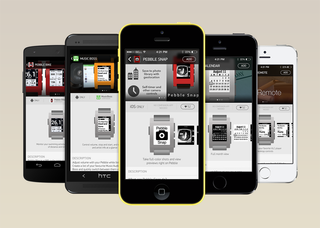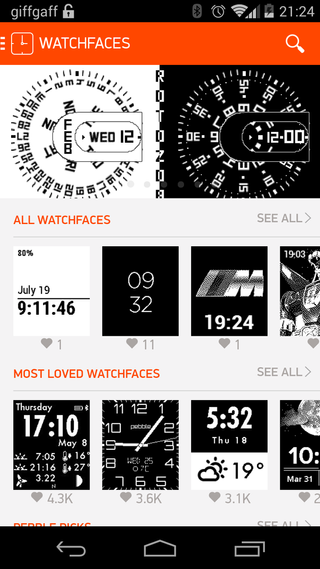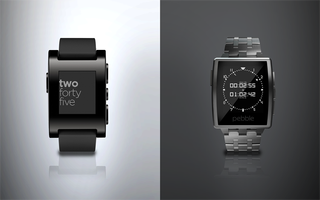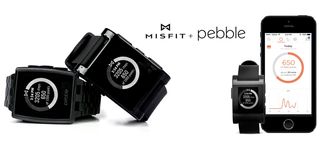You can trust Coach
The humble Pebble, a successful product of crowdfunding platform Kickstarter, could be credited with creating a new market for ‘smartwatches’. The original Pebble got right what a lot of other manufacturers had struggled with by providing excellent battery life and easy to use controls and its simplicity was one of its big selling points. Now it’s been followed by the Pebble Steel, which has a lot to live up to. We find out how it compares with its illustrious predecessor.
Pebble Steel vs Pebble
The creators of Pebble have most definitely taken a ‘if it ain’t broke, don’t fix it’ mentality with the Steel. Its internals are largely identical to those of its predecessor, save for including more memory, but it’s reassuring to know that all Pebble apps will still work on both watches regardless.
The differences between the two watches are mainly cosmetic. While the original Pebble used a lot of plastic and looked slightly cheap, the Steel has a much more premium feel to it. It’s made using precision-engineered stainless steel, which looks classier and is much stronger than the materials used for the Pebble. You get a choice of two finishes, brushed stainless or black matte, and both look stylish.

The ePaper display is retained from the original Pebble and is still one of the Steel’s best features. It means the display can be easily seen in bright sunlight, much more so than an LCD display, and that the Pebble Steel still offers excellent battery life. We only needed to charge once every four to five days, compared to other smartwatches that often need to be charged every day. The display itself is now also improved and uses Corning Gorilla Glass, the same material you see on many smartphones. This is a big step up from the original Pebble which was prone to scratching easily.
Rather than the silicone wrist strap that came with the original Pebble, you now get both a leather and metal strap withe Pebble Steel – a vast improvement in the style stakes. The Steel now resembles a more traditional watch so, for the fashionably inclined, it’s much easier to pair with your outfit without it sticking out like a sore thumb. The only downside is that, while the original Pebble supported conventional wrist straps so you could replace it with your own, the Steel now uses a proprietary design. This means you can now only get replacements from Pebble, limiting your choice of designs.
The Steel also uses a magnetic clasp charger like the original, but the connection itself has now changed. This means you can’t use your old charger if you’re upgrading, which is a minor annoyance. A new small LED light is now located on the front of the Steel to let you know when it’s charging and its current status, which is a useful addition.
Notifications and Apps
Smartwatches are designed to provide us important information in a more convenient manner than having to pull out our smartphones constantly. This is undoubtedly something the Pebble Steel does with great success.

Notifications for both Android and iOS are pushed straight to the watch face, so you instantly know when you receive a new SMS message or receive a phone call. The latter is particularly handy if you never hear or feel your phone ringing, and having the caller’s ID on your wrist lets you know if it’s worth getting your phone out. Controlling your music from your wrist is also useful.
Watch apps are the other big selling point for the Pebble Steel. You get access to the Pebble App store which was launched earlier this year and is steadily growing in size. This lets you expand the functionality of the Pebble Steel with apps across different categories like Daily and Health & Fitness. There’s some big-name support already available, such as FourSquare, which lets you check in to locations without ever having to get your phone out.
Looking to use the Pebble Steel as a fitness companion? That’s also well supported. There’s watch apps from the likes of RunKeeper and Endomondo that have good integration, and recently Pebble began partnering with Misfit. You can now use a Pebble or Pebble Steel as a Misfit sensor thanks to its included pedometer, removing the need to buy a Misfit Shine. However, the Misfit companion app to turn all of those recorded steps into more substantial information is limited to iOS at the moment. That’s one of the drawbacks of the Pebble App store, there’s a lack of parity between Android and iOS support for watch apps that require a companion app to be installed on your smartphone.

The Pebble App store also makes it easy to install new watch faces and there are a lot of good-looking options.
Verdict
The Pebble was an impressive bit of kit – and the Steel manages to improve on the original. It looks much more stylish and uses classier materials. But above all, the usefulness of the Pebble Steel really becomes evident when you either leave it at home or the battery dies on you – you realise it’s become a part of your everyday routine.
It’s more expensive than the original, at $250 (around £150), but the premium materials and design make up for the increased cost. An excellent smartwatch.
Score: 8/10

Coach is a health and fitness title. This byline is used for posting sponsored content, book extracts and the like. It is also used as a placeholder for articles published a long time ago when the original author is unclear. You can find out more about this publication and find the contact details of the editorial team on the About Us page.

Coros Vertix 2S Review: The Garmin Fenix Rival Gets Some Useful Upgrades

I Tried CrossFit Champ Mat Fraser’s Signature 40-Minute EMOM And It Helped Me Build Strength, Skill And Endurance In One Fell Swoop

I Took A Test To Find Out If I Had What It Takes To Be An Elite Athlete And It’s Changed My Training For The Better

